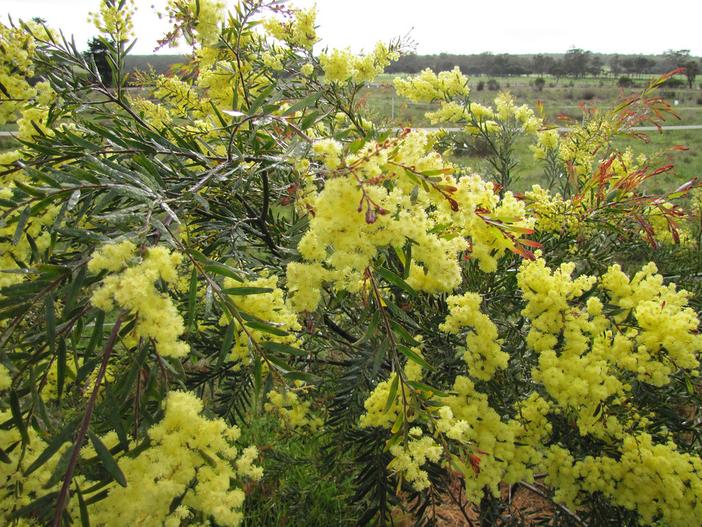Fringed Wattle
(Acacia fimbriata)
Fringed Wattle (Acacia fimbriata)
/
/

Brett and Sue Coulstock
CC BY 2.0
Image By:
Brett and Sue Coulstock
Recorded By:
Copyright:
CC BY 2.0
Copyright Notice:
Photo by: Brett and Sue Coulstock | License Type: CC BY 2.0 | License URL: https://creativecommons.org/licenses/by/2.0/ | Uploader: Red Moon Sanctuary | Publisher: Flickr


































Estimated Native Range
Summary
Acacia fimbriata, commonly known as Fringed Wattle, is an evergreen shrub or small tree native to the open eucalypt woodlands and forest margins of Eastern Australia. It exhibits an erect or spreading habit and typically reaches a height of 6 to 7 meters (20 to 23 ft) with a similar width. The Fringed Wattle is notable for its feathery foliage and bright yellow, puffball-like flowers that bloom between July and November. Each spherical flower-head is 3 to 5 mm (0.12 to 0.20 in) in diameter and contains 10 to 20 individual flowers. The inflorescences are arranged in groups of 8 to 25 along axillary racemes, creating a showy display that attracts pollinators.
The Fringed Wattle is valued for its fast growth, ease of maintenance, and the vibrant splash of color it provides when in bloom. It is commonly used as a hedge or screening plant and is appreciated for its ability to adapt to a range of conditions, including tropical environments and frost. It is also frost tolerant. In cultivation, it thrives in full sun to part shade and requires low to moderate watering, preferring soils with medium to fast drainage. While it is available in seed form for gardeners, it is important to note that the plant can become weedy if not managed properly, and it may require regular pruning to maintain its shape and prevent unwanted spread.CC BY-SA 4.0
The Fringed Wattle is valued for its fast growth, ease of maintenance, and the vibrant splash of color it provides when in bloom. It is commonly used as a hedge or screening plant and is appreciated for its ability to adapt to a range of conditions, including tropical environments and frost. It is also frost tolerant. In cultivation, it thrives in full sun to part shade and requires low to moderate watering, preferring soils with medium to fast drainage. While it is available in seed form for gardeners, it is important to note that the plant can become weedy if not managed properly, and it may require regular pruning to maintain its shape and prevent unwanted spread.CC BY-SA 4.0
Plant Description
- Plant Type: Shrub, Tree
- Height: 18-23 feet
- Width: 13-17 feet
- Growth Rate: Rapid
- Flower Color: Yellow
- Flowering Season: Winter, Spring
- Leaf Retention: Evergreen
Growth Requirements
- Sun: Full Sun, Part Shade
- Water: Low
- Drainage: Medium, Fast
Common Uses
Bee Garden, Bird Garden, Drought Tolerant, Hedges, Hummingbird Garden, Low Maintenance, Showy Flowers, Street Planting
Natural Habitat
Open eucalypt woodlands and forest margins
Other Names
Common Names: Brisbane Golden Wattle, Goldenrain Wattle
Scientific Names: , Acacia fimbriata, Acacia perangusta, Acacia fimbriata var. perangusta, Acacia fimbriata var. glabra, Acacia prominens var. fimbriata, Acacia prominens var. whiteana, Racosperma fimbriatum, Racosperma perangustum,
GBIF Accepted Name: Acacia fimbriata A.Cunn. ex G.Don